The Demonization of Empress Wu
“She killed her sister, butchered her elder brothers, murdered the ruler, poisoned her mother,” the chronicles say. But is the empress unfairly maligned?
![]()
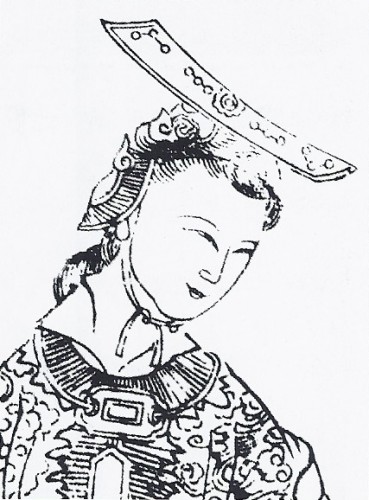
A 17th-century Chinese depiction of Wu, from Empress Wu of the Zhou, published c.1690. No contemporary image of the empress exists.
Most nations of note have had at least one great female leader. Not the United States, of course, but one thinks readily enough of Hatshepsut of ancient Egypt, Russia’s astonishing Catherine the Great, or Trung Trac of Vietnam.
These women were rarely chosen by their people. They came to power, mostly, by default or stealth; a king had no sons, or an intelligent queen usurped the powers of her useless husband. However they rose, though, it has always been harder for a woman to rule effectively than it was for a man–more so in the earlier periods of history, when monarchs were first and foremost military leaders, and power was often seized by force.
So queens and empresses regnant were forced to rule like men, and yet roundly criticized when they did so. Sweden’s fascinating Queen Christina was nearly as infamous for eschewing her sidesaddle and riding in breeches as she was for the more momentous decision that she took to convert to Catholicism–while mustering her troops in 1588 as the Spanish Armada sailed up the Channel, even Elizabeth I felt constrained to begin a morale-boosting address with a denial of her sex: “I know I have the body of a weak and feeble woman, but I have the heart and stomach of a king, and a king of England too.”
Of all these female rulers, though, none has aroused so much controversy, or wielded such great power, as a monarch whose real achievements and character remain obscured behind layers of obloquy. Her name was Wu Zetian, and in the seventh century A.D. she became the only woman in more than 3,000 years of Chinese history to rule in her own right.
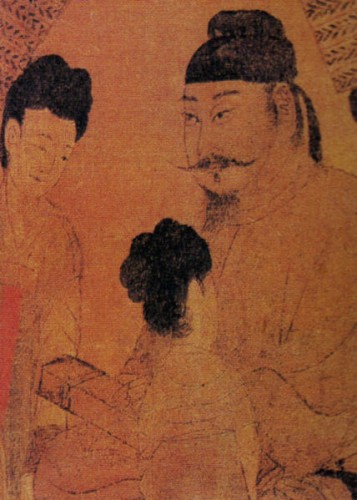
The Tang emperor Taizong was the first to promote Wu, whom he gave the nickname “Fair Flatterer”–a reference not to her personal qualities but to the lyrics of a popular song of the day.
Wu (she is always known by her surname) has every claim to be considered a great empress. She held power, in one guise or another, for more than half a century, first as consort of the ineffectual Gaozong Emperor, then as the power behind the throne held by her youngest son, and finally (from 690 until shortly before her death in 705) as monarch. Ruthless and decisive, she stabilized and consolidated the Tang dynasty at a time when it appeared to be crumbling–a significant achievement, since the Tang period is reckoned the golden age of Chinese civilization. T.H. Barrett’s recent book even suggests (on no firm evidence) that the empress was the most important early promoter of printing in the world.
Yet Wu has had a pretty bad press. For centuries she was excoriated by Chinese historians as an offender against a way of life. She was painted as a usurper who was both physically cruel and erotically wanton; she first came to prominence, it was hinted, because she was willing to gratify certain of the Taizong emperor‘s more unusual sexual appetites. “With a heart like a serpent and a nature like that of a wolf,” one contemporary summed up, “she favored evil sycophants and destroyed good and loyal officials.” A small sampling of the empress’s other crimes followed: “She killed her sister, butchered her elder brothers, murdered the ruler, poisoned her mother. She is hated by gods and men alike.”
Just how accurate this picture of Wu is remains a matter of debate. One reason, as we have already had cause to note in this blog, is the official nature and lack of diversity among the sources that survive for early Chinese history; another is that imperial history was written to provide lessons for future rulers, and as such tended to be weighted heavily against usurpers (which Wu was) and anyone who offended the Confucian sensibilities of the scholars who labored over them (which Wu did simply by being a woman). A third problem is that the empress, who was well aware of both these biases, was not averse to tampering with the record herself; a fourth is that some other accounts of her reign were written by relatives who had good cause to loathe her. It is a challenge to recover real people from this morass of bias.
The most serious charges against Wu are handily summarized in Mary Anderson’s collection of imperial scuttlebutt, Hidden Power, which reports that she “wiped out twelve collateral branches of the Tang clan” and had the heads of two rebellious princes hacked off and brought to her in her palace. Among a raft of other allegations are the suggestions that she ordered the suicides of a grandson and granddaughter who had dared to criticize her and later poisoned her husband, who–very unusually for a Chinese emperor–died unobserved and alone, even though tradition held that the entire family should assemble around the imperial death bed to attest to any last words.
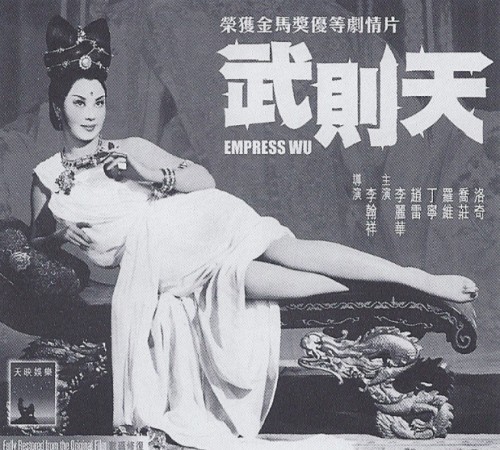
Wu–played here by Li Lihua–was depicted as powerful and sexually assertive in the Shaw Brothers’ 1963 Hong Kong movie Empress Wu Tse-Tien.
Even today, Wu remains infamous for the spectacularly ruthless way in which she supposedly disposed of Gaozong’s first wife, the empress Wang, and a senior and more favored consort known as the Pure Concubine. According to the histories of the period, Wu smothered her own week-old daughter by Gaozong and blamed the baby’s death on Wang, who was the last person to have held her. The emperor believed her story, and Wang was demoted and imprisoned in a distant part of the palace, soon to be joined by the Pure Concubine. Having risen to be empress in Wang’s stead, Wu ordered that both women’s hands and feet be lopped off and had their mutilated bodies tossed into a vat of wine, leaving them to drown with the comment: “Now these two witches can get drunk to their bones.”
As if infanticide, torture and murder were not scandalous enough, Wu was also believed to have ended her reign by enjoying a succession of erotic encounters which the historians of the day portrayed as all the more shocking for being the indulgences of a woman of advanced age. According to Anderson, servants
provided her with a string of virile lovers such as one lusty, big-limbed lout of a peddler, whom she allowed to frequent her private apartments…. In her seventies, Wu showered special favor on two smooth-cheeked brothers, the Zhang brothers, former boy singers, the nature of whose private relationship with their imperial mistress has never been precisely determined. One of the brothers, she declared, had “a face as beautiful as a lotus flower,” while it is said she valued the other for his talents in the bedchamber…. the empress, greatly weakened by infirmity and old age, would allow no one but the Zhang brothers by her side.
Determining the truth about this welter of innuendo is all but impossible, and matters are complicated by the fact that little is known of Wu’s earliest years. She was the daughter of a minor general called Duke Ding of Ying, and came to the palace as a concubine in about 636–an honor that suggests that she was very beautiful, since, as Jonathan Clements remarks, “admission to the ranks of palace concubines was equivalent to winning a beauty contest of the most gorgeous women in the medieval world.” But mere beauty was not sufficient to elevate the poorly connected teenage Wu past the fifth rank of palace women, a menial position whose duties were those of a maid, not a temptress.
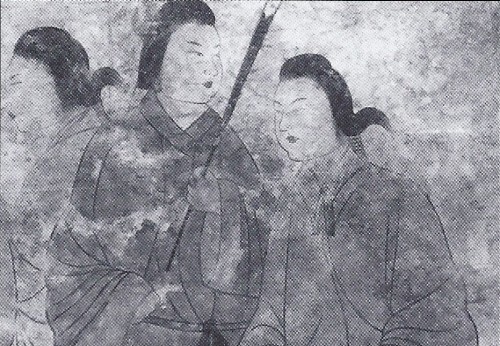
Palace ladies of the Tang dynasty, from a contemporary wall painting in an imperial tomb in Shaanxi.
The odds that a girl of this low rank would ever come to an emperor’s attention were slim. True, Taizong–an old warrior-ruler so conscientious that he had official documents pasted onto his bedroom walls so that he would have something to work on if he woke in the night–had lost his empress shortly before Wu entered the palace. But 28 other consorts still stood between her and the throne.
Though Wu was unusually well-read and self-willed for a mere concubine, she had only one real advantage over her higher-ranked rivals: Her duties included changing the imperial sheets, which potentially gave her bedroom access to Taizong. Even if she took full advantage, however, she must have possessed not only looks but remarkable intelligence and determination to emerge, as she did two decades later, as empress.
Attaining that position first required Wu to engineer her escape from a nunnery after Taizong’s death–the concubines of all deceased emperors customarily had their heads shaved and were immured in convents for the rest of their lives, since it would have been an insult to the dead ruler had any other man sullied them–and to return to the palace under Gaozong’s protection before entrancing the new emperor, removing empress Wang and the Pure Concubine, promoting members of her own family to positions of power, and eventually establishing herself as fully her husband’s equal. By 666, the annals state, Wu was permitted to make offerings to the gods beside Gaozong and even to sit in audience with him–behind a screen, admittedly, but on a throne that was equal in elevation to his own.
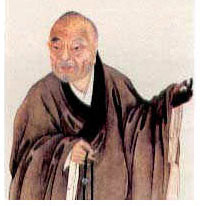
The poet Luo Binwang–one of the “Four Greats of Early Tang” and best known for his “Ode to the Goose”–launched a virulent attack on the empress. Wu, characteristically, admired the virtuosity of Luo’s style and suggested he would be better employed at the imperial court.
Wu’s later life was one long illustration of the exceptional influence she had come to wield. After Gaozong’s death, in 683, she remained the power behind the throne as dowager empress, manipulating a succession of her sons before, in 690, ordering the last of them to abdicate and taking power herself. Not until 705, when she was more than 80 years old, was Wu finally overthrown by yet another son–one whom she had banished years before. Her one mistake had been to marry this boy to a concubine nearly as ruthless and ambitious as herself. Throughout 15 dismal years in exile, her son’s consort had talked him out of committing suicide and kept him ready to return to power.
So much for the supposed facts; what about the interpretation? How did a woman with such limited expectations as Wu emerge triumphant in the cutthroat world of the Tang court? How did she hold on to power? And does she deserve the harsh verdict that history has passed on her?
One explanation for Wu’s success is that she listened. She installed a series of copper boxes in the capital in which citizens could post anonymous denunciations of one another, and passed legislation, R.W.L. Guisso says, that “empowered informers of any social class to travel at public expense.” She also maintained an efficient secret police and instituted a reign of terror among the imperial bureaucracy. A history known as the Comprehensive Mirror records that, during the 690s, 36 senior bureaucrats were executed or forced to commit suicide, and a thousand members of their families enslaved.
Yet contemporaries thought that there was more to her than this. One critic, the poet Luo Binwang, portrayed Wu as little short of an enchantress–”All fell before her moth brows. She whispered slander from behind her sleeves, and swayed her master with vixen flirting”– and insisted that she was the arch manipulator of an unprecedented series of scandals that, over two reigns and many years, cleared her path to the throne.
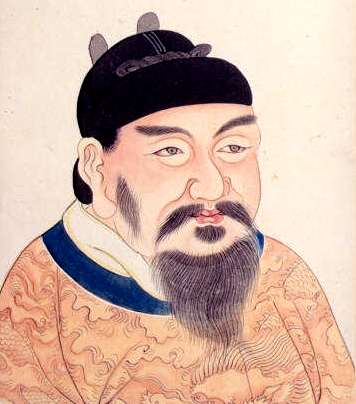
Most historians believe Wu became intimate with the future Gaozong emperor before his father’s death–a scandalous breach of etiquette that could have cost her her head, but which in fact saved her from life in a Buddhist nunnery.
What role, if any, the undeniably ambitious concubine played in the events of the early Tang period remains a matter of controversy. It is not likely Wu was involved in the disgrace of Taizong’s unpleasant eldest son, Cheng-qian, whose teenage rebellion against his father had taken the form of the ostentatious embrace of life as lived by Mongol nomads. (“He would camp out in the palace grounds,” Clements notes, “barbecuing sheep.”) Cheng-qian was banished for attempted revolt, while a dissolute brother who had agreed to take part in the rebellion–”so long,” Clements adds, “as he was permitted sexual access to every musician and dancer in the palace, male or female”–was invited to commit suicide, and another of Taizong’s sons was disgraced for his involvement in a different plot. Yet it was this series of events that cleared the way for Gaozong’s, and hence Wu’s, accession.
It is easier to take seriously the suggestion that Wu arranged a series of murders within her own family. These began in 666 with the death by poison of a teenage niece who had attracted Gaozong’s admiring gaze, and continued in 674 with the suspicious demise of Wu’s able eldest son, crown prince Li Hong, and the discovery of several hundred suits of armor in the stables of a second son, who was promptly demoted to the rank of commoner on suspicion of treason. Historians remain divided as to how far Wu benefited from the removal of these potential obstacles; what can be said is that her third son, who succeeded his father as Emperor Zhongzong in 684, lasted less than two months before being banished, at his mother’s instigation, in favor of the more tractable fourth, Ruizong. It is also generally accepted that Ruizong’s wife, Empress Liu, and chief consort, Dou, were executed at Wu’s behest in 693 on trumped-up charges of witchcraft.
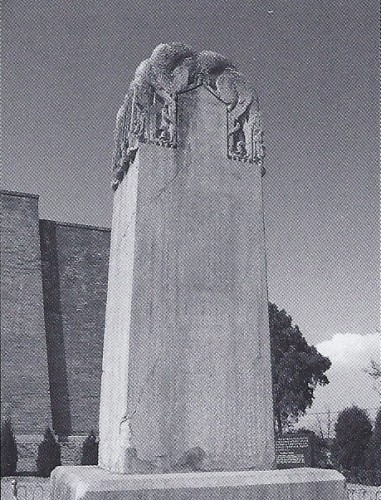
Wu’s memorial tablet, which stands near her tomb, was erected during her years as empress in the expectation that her successors would compose a magnificent epitaph for it. Instead, it was left without any inscription–the only such example in more than 2,000 years of Chinese history.
There are abundant signs that Wu was viewed with deep suspicion by later generations of Chinese. Her giant stone memorial, placed at one side of the spirit road leading to her tomb, remains blank. It is the only known uncarved memorial tablet in more than 2,000 years of imperial history, its muteness chillingly reminiscent of the attempts made by Hatshepsut’s successors to obliterate her name from the stone records of pharaonic Egypt. And while China’s imperial chronicles were too rigidly run and too highly developed for Wu’s name to be simply wiped from their pages, the stern disapproval of the Confucian mandarins who compiled the records can still be read 1,500 years later.
How to evaluate such an unprecedented figure today? It may be helpful to consider that there were in effect two empresses–the one who maintained a reign of terror over the innermost circle of government, and the one who ruled more benignly over 50 million Chinese commoners. Seen from this perspective, Wu did in fact fulfill the fundamental duties of a ruler of imperial China; Confucian philosophy held that, while an emperor should not be condemned for acts that would be crimes in a subject, he could be judged harshly for allowing the state to fall into anarchy. C.P. Fitzgerald–who reminds us that Tang China emerged from 400 years of discord and civil war–writes, “Without Wu there would have been no long enduring Tang dynasty and perhaps no lasting unity of China,” while in a generally favorable portrayal, Guisso argues that Wu was not so different from most emperors: “The empress was a woman of her times. Her social, economic and judicial views could hardly be termed advanced, and her politics differed from those of her predecessors chiefly in their greater pragmatism and ruthlessness.” Even the “terror” of the 680s, in this view, was a logical response to entrenched bureaucratic opposition to Wu’s rule. This opposition was formidable; the annals of the period contain numerous examples of criticisms leveled by civil servants mortified by the empress’s innovations. At one point, to the horror of her generals, Wu proposed raising a military corps from among China’s numerous eunuchs. (It was common for poor Chinese boys to voluntarily undergo emasculation in the hope of obtaining a prestigious and well-remunerated post in the imperial service). She was also the most important early supporter of the alien religion of Buddhism, which during her rule surpassed the native Confucian and Daoist faiths in influence within the Tang realm.
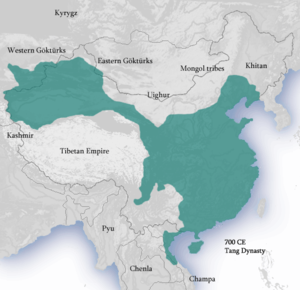
The Tang empire in 700, at the end of Wu’s reign. Her 50-year rule was marked by a successful foreign policy that saw only a few, victorious, wars but the considerable expansion of the influence of the Chinese state. Map: Wikicommons.
All in all, Wu’s policies seem less scandalous to us than they did to contemporaries, and her reputation has improved considerably in recent decades. Her reign was peaceful and prosperous; she introduced the meritocratic system of entrance examinations for the imperial bureaucracy that survived into the 20th century, avoided wars and welcomed ambassadors from as far away as the Byzantine Empire. Moreover, Wu exhibited one important characteristic that suggests that, whatever her faults, she was no despot: She acknowledged and often acted on the criticisms of loyal ministers, one of whom dared to suggest, in 701, that it was time for her to abdicate. The empress even promoted what might loosely be termed women’s rights, publishing (albeit as part of her own legitimation campaign) Biographies of Famous Women and requiring children to mourn both parents, rather than merely their father, as had been the practice hitherto. The critical Anderson concedes that, under Wu, “military expenses were reduced, taxes cut, salaries of deserving officials raised, retirees given a viable pension, and vast royal lands near the capital turned over to husbandry.”
Explaining why the empress was so reviled, then, means acknowledging the double standard that existed–and still exists–when it comes to assessing male and female rulers. Wu probably did dispose of several members of her own family, and she ordered the deaths of a number of probably innocent ministers and bureaucrats. She also dealt ruthlessly with a succession of rivals, promoted members of her own family to high office, succumbed repeatedly to favoritism, and, in her old age, maintained what amounted to a harem of virile young men. None of these actions, though, would have attracted criticism had she been a man. Every Chinese emperor had concubines, and most had favorites; few came to power, or stayed there, without the use of violence. Taizong forced the abdication of his own father and disposed of two older brothers in hand-to-hand combat before seizing the throne.
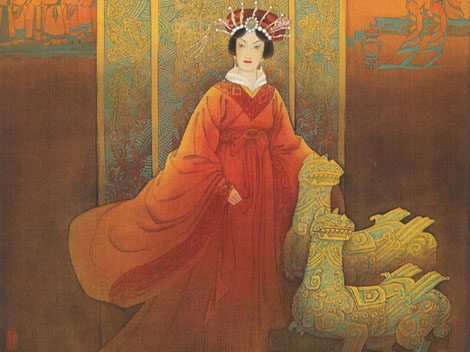
Empress Lu Zhi (241-180 B.C.) is held up in Chinese histories as the prototype of all that is wicked in a female ruler. Cold, ruthless, and ambitious, the Han dynasty dowager murdered her rival, the beautiful concubine Lady Qi, by amputating all her limbs, turning her into a “human swine” and leaving her to die in a cesspit.
There must also be some doubt as to whether Wu really was guilty of some of the most monstrous crimes that history has charged her with. The horrible deaths of empress Wang and the Pure Concubine, for example, are nowhere mentioned in Luo Binwang’s fearless contemporary denunciation, which suggests that Wu was not blamed for them during her lifetime. Her supposed method, moreover–amputating her victims’ hands and feet and leaving them to drown–suspiciously resembles that adopted by her most notorious predecessor, the Han-era empress Lu Zhi–a woman portrayed by Chinese historians as the epitome of all that was evil. It was Lu Zhi who, in 194 B.C., wreaked revenge on a rival by gouging out her eyes, amputating her arms and legs, and forcing her to drink acid that destroyed her vocal chords. The mute and limbless concubine was then tossed into a cesspit in the palace with the swine. It seems possible that the fate ascribed to Wang and the Pure Concubine was a chronicler’s invention, intended to link Wu to the worst monster in China’s history.
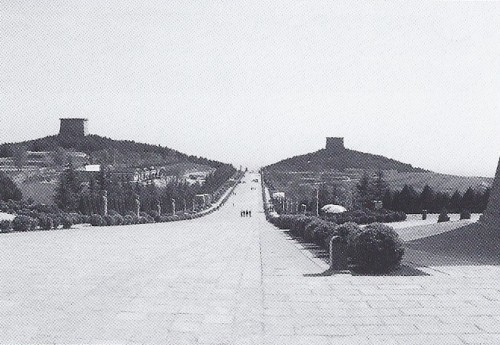
The “spirit road” causeway to Wu’s still-unopened tomb lies between two low rises, tipped by watchtowers, known as the “nipple hills.”
In death, as in life, then, Wu remains controversial. Even her gravesite is remarkable. When she died, she was laid to rest in an elaborate tomb in the countryside about 50 miles north of the then capital, Xi’an. It was approached via a mile-long causeway running between two low hills topped with watchtowers, known today as the “nipple hills” because Chinese tradition holds that the spot was selected because the hills reminded Gaozong of the young Wu’s breasts.
At the end of this “spirit road,” the tomb itself lies in a remarkably inaccessible spot, set into a mountain at the end of a winding forest path. No-one knows what secrets it holds, for like many of the tombs of the most celebrated Chinese rulers, including that of the First Emperor himself, it has never been plundered or opened by archaeologists.
Sources
Mary Anderson. Hidden Power: The Palace Eunuchs of Imperial China. Amherst : Prometheus Books, 1990; T.H. Barrett. The Woman Who Discovered Printing. New Haven: YUP, 2008; Jonathan Clements. Wu: the Chinese Empress Who Schemed, Seduced and Murdered Her Way to Become A Living God. Stroud: Sutton Publishing, 2007; Dora Shu-Fang Dien, Empress Wu Zetian in Fiction and in History: Female Defiance in Confucian China. Hauppauge : Nova Science Publishers, 2003; Richard Guisso, Wu Tse-T’ien and the Politics of Legitimation in T’ang China. Bellingham : EAS Press, 1978; Robert Van Gulik. Sexual Life in Ancient China: A Preliminary Survey of Chinese Sex and Society from ca.1500 BC till 1644 AD. Leiden: EJ Brill, 1974.
.
/https://tf-cmsv2-smithsonianmag-media.s3.amazonaws.com/accounts/headshot/mike-dash-240.jpg)
/https://tf-cmsv2-smithsonianmag-media.s3.amazonaws.com/accounts/headshot/mike-dash-240.jpg)